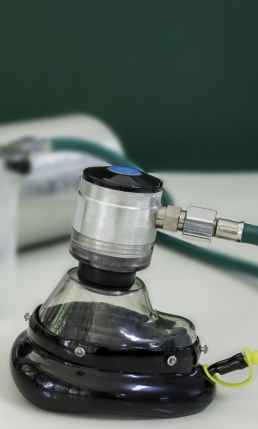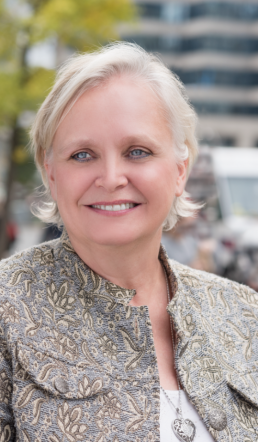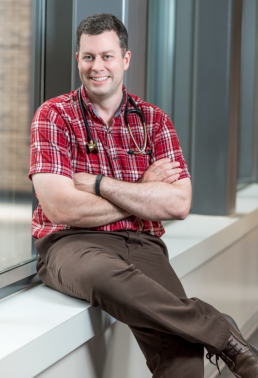Paula and David: Difficult experiences amid excellent care
See Paula & David’s story in Chapter 1
Since being rushed to emergency with respiratory and heart problems on his last day of work before retirement in 2013, David has spent a year-and-half in hospital. He is now at home on 24-hour oxygen and uses a ventilator at night. His wife Paula has accompanied him to the emergency department about 10 times since that day.
On two of those occasions, David was in critical condition and was taken almost immediately to the intensive care unit. “He never had to wait on a gurney in emerg for anything,” notes Paula. On other occasions, when David was having trouble breathing, the emergency visit usually lasted only two to three hours. “When he would just need a respiratory intervention, that was done in a very timely fashion and we were on our way.”
However, while David has received a lot of excellent care in emergency departments, there were a lot of negative experiences as well, says Paula.
One time, David’s family doctor sent them to emergency with a letter explaining he needed to be seen as soon as possible. David was confused and incoherent, and his blood pressure was elevated. After showing the letter to the triage nurse, he waited two hours to see a doctor. “It turned out he had carbon dioxide blood poisoning and he could have died waiting,” says Paula.
Many of their other difficult experiences in hospital emergency departments were related to crowding.For example, Paula says they have frequently waited for care amid other patients who were coughing, sneezing and vomiting and were quite likely infectious, which was particularly upsetting when David was in such frail health.
Paula has also experienced a lack of privacy and consideration in busy emergency departments. When David was taken to emergency on his final workday, she remembers being told by a doctor in a busy waiting area that he was in critical condition. The doctor then left without answering questions or directing her to someone who might answer them. “I was just left standing there,” she recalls. “You’re in shock. That was a really big disconnect with the doctor. That was a horrible experience.”
But on another occasion when David was brought to another emergency department in critical condition, she was given a chair to sit on outside the room where he was being treated, and first a nurse and then a doctor came out to talk to her. “That was a totally different experience,” she recalls.
A new tool for better triage
To improve the accuracy and efficiency of the triage process that determines the order in which emergency department patients are seen, hospitals across Ontario will soon be adopting a new electronic triage system.It’s being developed and implemented by Cancer Care Ontario – the Ontario government’s principal advisor on cancer and chronic kidney disease care and on access to care for key health services.
The new system, called eCTAS, is based on the Canadian Triage and Acuity Scale (CTAS) that assigns each patient a score that reflects the urgency of their illness. The goal of eCTAS is to improve triage by guiding emergency nurses through a comprehensive,common assessment and documentation process that is expected to lead to more accurate and more consistent evaluation of each patient’s condition.
“It was designed by emergency nurses in Ontario specifically for emergency nurses to triage patients,”says Joy McCarron, a nurse who is Cancer Care Ontario’s clinical leader for the implementation of eCTAS across the province. She has over 20 years of experience in triage and triage training.
While eCTAS will automatically assign patients a CTAS score based on information about their condition that is entered into a computer by the triage nurse, nurses will still be free to use their own clinical judgment to assign patients a higher score indicating a more urgent need for care.
Many Ontario hospitals are already using electronic triage, but they are using a variety of systems, with mixed results, says McCarron. She says some of the systems, for example, require too much information that turns the process into a broader assessment rather than triage, which slows the triage process and thereby slows patient flow in emergency.
The eCTAS system will be made available to all hospitals in the province. When hospitals were asked to volunteer to be among the first to adopt it, 23 volunteered, more than double what was anticipated, notes McCarron.
Across Ontario, 122 of the 128 hospitals that have emergency departments have signed on to be part of the eCTAS initiative. By 2018, says McCarron, it’s expected that eCTAS will be used in hospitals that care for 87% of the province’s population.
As part of the evaluation being done on eCTAS, McCarron, an expert triage auditor, performed live triage audits– sitting at the triage desk and seeing and hearing the same patients as triage nurses on duty. Once eCTAS is implemented, live audits will be repeated to see how the results of the triage nurses compare to the results of an expert auditor after the system is in place. Pre-implementation triage time was also evaluated to ensure eCTAS implementation does not significantly affect triage assessment time.
“We expect there to be a learning curve,” says McCarron, “and so initially we expect some hospitals to experience a bit longer triage, which will be rectified by the staff becoming more familiar with the new system.”
It remains to be seen whether eCTAS will shorten the triage process by making it more efficient, says McCarron. But it is meant to improve consistency and accuracy, which should improve overall emergency care. “At the very least, we’ll know who the sick patients are, where right now there’s a risk that we may not be identifying all of the very ill patients.”
Finding creative ways to adapt
See Dr. Chernoff’s story in Chapter 2
While some doctors may see emergency medicine as too hectic and devoid of opportunities to form the long-term relationships with patients that many doctors cherish, emergency physician Dr. Ian Chernoff considers caring for 25 to 30 new patients every day to be an opportunity to do a lot of good.
“In terms of just having the potential to be a positive force in health care for a maximum number of patients, it is hard to match the opportunity that emergency medicine presents,” explains Dr.Chernoff, who works full-time in the emergency department at Mount Sinai Hospital.
“Often we’re seeing people and families at absolutely pivotal and once-in-a-lifetime moments,” he notes. “I’ve always felt quite privileged to be able to be involved with people at those times of their lives. There’s just an immense opportunity there to try to be a good person and a good physician and provide compassionate care.”
Dr. Chernoff has been providing care to emergency patients for 19 years, and things have changed quite a bit over those years. Overall, he’s seeing more patients, more older patients, and more patients with complex health problems.
Emergency medicine has adapted to the pressures created by these changes in many ways that have actually improved care, says Dr. Chernoff. For example, there are more types of staff available – such as physician assistants, nurse practitioners, advanced practice geriatric nurses and physiotherapists – to provide care. And there is much more of a team approach, he explains, with doctors sharing important decision-making roles with these new staff members.
Staff also have more options other than admission to hospital available for patients whose needs can’t be completely addressed during their emergency visit, including home care and community health services.
But these kinds of changes haven’t relieved all the pressure. Dr. Chernoff says the two biggest barriers his emergency department faces in trying to deal efficiently with more patients, and patients with increasingly complex conditions, are the small physical space available to care for them, and a shortage of inpatient beds for patients waiting in emergency for admission.
When Dr. Chernoff started working at Mount Sinai Hospital’s emergency department 10 years ago, five extra beds in a hallway were used for patient overflow. Now there are five more in another hallway, and five more in a hall in the waiting area. And it’s still often not enough.
“I now routinely go out and assess patients in the waiting room, and that’s suboptimal in many ways,” says Dr. Chernoff, adding he does those assessments to at least get care started for patients when there are no emergency beds available.
Waiting room assessments are among the many “creative” adaptations he says emergency departments are making to deal with patient overflows. But he believes the crowding does affect quality of care to some extent. “For an elderly patient who is already ill enough that they’ve had to come to the emergency department, if they have to lie in a hallway and there’s bright light and there’s noise and they don’t sleep for a period of time, that is not good for their medical condition.”
An expansion of his emergency department is already in the works, and Dr. Chernoff believes such growth in capacity is sometimes needed in addition to innovation and adaptation.
“I think things need to move in concert. You can be the most efficient emergency department on the planet, but if there are not more inpatient beds and there is not more physical space to see patients, if nothing else changes and the pressures just get added upon, then ultimately, of course, there’s only so much you can do in such circumstances.”
Rapid Referral Clinic a win for everyone
See Dr. Slaughter’s story in Chapter 3
A new way of doing things is helping to improve care for some patients coming in with complex health conditions to the busy emergency department at Sunnybrook Health Sciences Centre.
Adult patients with serious health issues who need prompt, but not immediate, care may be referred by an emergency department doctor to Sunnybrook’s Rapid Referral Clinic. There, they will be seen within a few days by an internist – a doctor who specializes in the diagnosis and nonsurgical treatment of adults.
These are patients who might otherwise have to wait many hours in emergency for a consultation with an internist and for diagnostic testing, or be admitted to hospital for their condition to be investigated, or be discharged home to wait weeks or even months to see a specialist and have diagnostic tests done.
Instead, patients get to leave the emergency department with an appointment to be seen, often the next day, at the Rapid Referral Clinic.
“We have expedited access to the same type of testing that can happen in the emergency room, in order to get investigations done,” explains Dr. Graham Slaughter, who heads the clinic. Patients who need laboratory tests, or tests such as CT scans, ultrasound scans and pulmonary function tests, can have them done the same day. The clinic also has expedited access to consultations with specialists in areas such as neurology and rheumatology. And, if necessary, patients can be admitted to hospital.
Donald came to the clinic as a patient after going to the emergency department on the advice of his doctor, who was concerned when the 89-year-old developed jaundice, which can indicate problems with the liver. After spending seven hours in emergency he was referred to the clinic, where he saw Dr. Slaughter the next day.
“I was extremely impressed by him,” says Donald. “He arranged for me to have, first of all, a CT scan, and then on the results of that, a liver biopsy, all in fairly short order.
Donald believes the clinic “cuts down on a lot of angst and worry” for patients like himself who are anxious to find out what’s wrong with them. He notes he might have had to wait a couple of months for a CT scan if he had not gone to emergency and been referred to the clinic. “Naturally if there’s a possibility of cancer lurking around in the background, it could possibly even save your life.”
Donald’s scan indicated a mass in his liver that could be cancer, so Dr. Slaughter also arranged an appointment for him with a specialist at the hospital’s cancer centre. Despite the worrisome outcome of his visit to the clinic, Donald is pleased that the time from that visit to his visit with a cancer specialist will only be two to three weeks. “Waiting is very stressful,” he says, “waiting and not knowing.”
”The clinic isn’t appropriate for patients such as those who need oxygen or intravenous antibiotics,or whose condition is already being monitored by a specialist. But when referral to the clinic is appropriate, it’s a win for everyone involved.
For the hospital, it means being able to reduce emergency department crowding and admissions. For the patient, it means being able to go home and still receive the care they need in a timely manner.
“You also are trying to keep them in their own bed and as much as possible going about their lives as ordinarily as possible,” says Dr. Slaughter. “An admission can be a horribly intrusive thing.”
Sunnybrook’s own data show 22% of the patients seen at the clinic would have been admitted to hospital if it were not available. The clinic has also created cost efficiencies that freed up approximately $1 million per year. And, it has resulted in satisfied patients.
“Patients seem to be genuinely happy with the effort that’s put forward, with the relative speed at which they get seen and the thoroughness of the work that we do,” says Dr. Slaughter.
Rosemary: A long wait in pain
See Rosemary’s story in Chapter 3
Rosemary’s back pain took a horrible turn for the worse immediately after she took what was supposed to be a soothing bath on the advice of her physiotherapist.
“I was standing in my bathroom and I suddenly had this pain, but it was overwhelming,” she recalls.“That’s all I remember, standing in the bathroom with this pain and then the next thing I remember I’m waking up and my head is beside the toilet and I’m lying on the bathroom floor and all I could do was scream.”
Rosemary crawled very slowly to her bed. She didn’t go to emergency until she could find someone to look after her three dogs. After she called 911 and was taken by ambulance to an urban community hospital emergency department, Rosemary waited five or six hours on a stretcher in a hallway before a doctor saw her. The pain medication she had been taking at home had begun to wear off soon after her arrival.
“They told me I couldn’t take anything that wasn’t administered by them and they were too busy to see me, and I’m lying there in complete agony with no help.” She says she was in a hallway for her entire 15-hour stay in emergency, except for the brief periods when she was taken for testing and catheterization.
“I think two or three doctors came to me while I was in emerg. They asked me the same questions: ‘Do you know what happened? What do you think caused it?’ Two, three minutes and then they were gone. The third guy, which I suspect was like eight hours there now, gave me a pain pill which didn’t take the pain away, just made me feel a little bit better.”
After a CT scan was done, Rosemary was told she appeared to have a large but non-malignant tumour at the base of her spine, and that she would have an MRI scan to determine exactly what was wrong. She was given medication called gabapentin, which made the pain go away for about an hour-and-a-half at a time, and a few hours later she was admitted to the hospital as an inpatient.
But Rosemary says some misunderstanding or miscommunication must have occurred because she was in a lot of pain but was no longer given gabapentin in the inpatient ward, even though she had told the nurse in emergency that it relieved her pain.
She says such problems could be dealt with more effectively if patients had immediate access to their records, because she saw in her records after leaving the hospital that the nurse had written that Rosemary didn’t want gabapentin.
The MRI scan showed Rosemary had a ruptured disc that had initially looked like a tumour because so much disc material had escaped. She spent 10 days in hospital and a year incapacitated at home, and is still not able to do all the things she did six years ago before her injury.
Rosemary says she has visited emergency departments about a dozen other times over the past eight years and the visits have lasted eight or nine hours each time. She believes that’s too long and that emergency care can and should be improved.
“It is not efficient, it is not functioning well. It’snot like the people there aren’t trying. They’re just overwhelmed, and when people get overwhelmed they actually get less productive.”




